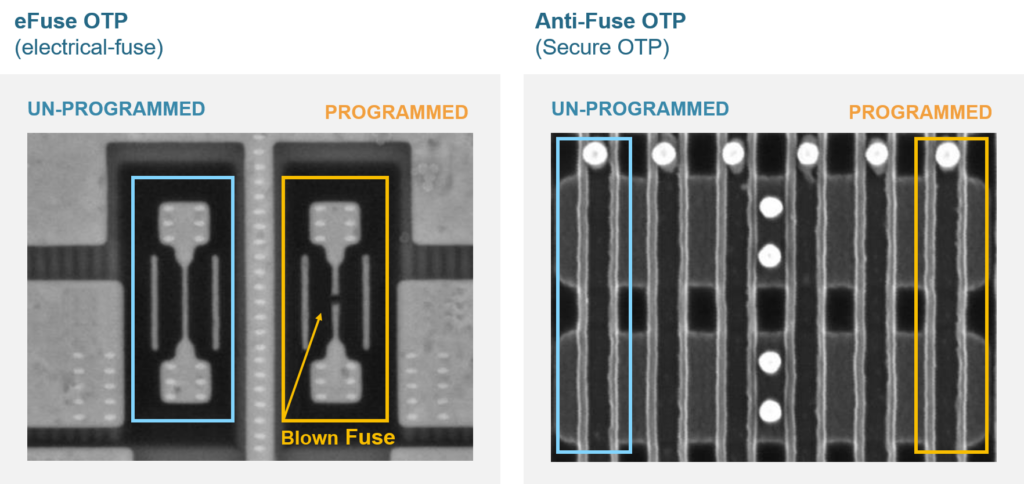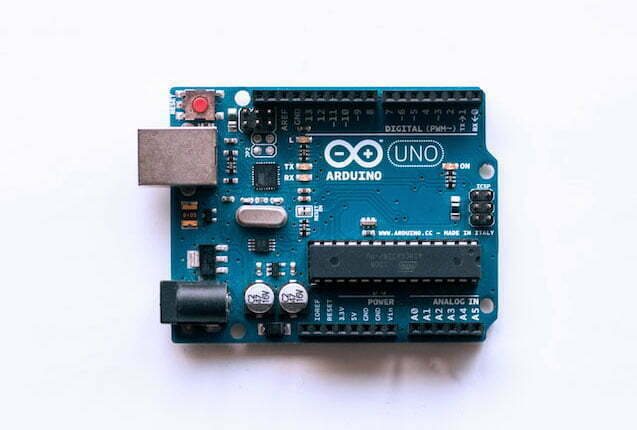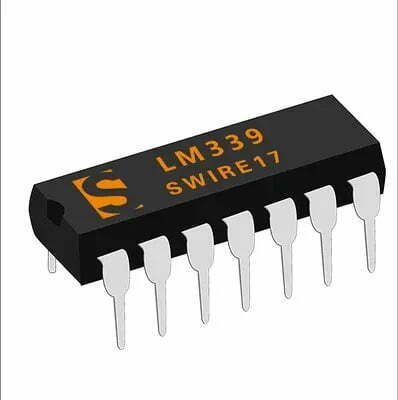One Time Programmable (OTP) memory is non-volatile, meaning it retains its data when powered off. It is a special type of read-only memory that can only be programmed or written to once. Once this memory has been programmed or written, it cannot be rewritten again without special equipment and procedures.
Programming OTP memory requires specialized equipment because the memory needs to be exposed to ultraviolet light for a precise amount of time and intensity or other similar conditions. These conditions are not something that could normally happen by accident and require extremely specific conditions in order to program the memory.
This small guide will introduce readers to what One Time Programmable (OTP) memory is, how it’s used and some examples of where you might find OTP memory in your everyday life.
What is OTP in SOC Chips?
In SOC chips, OTP (One-Time Programmable) is a type of non-volatile memory that can only be programmed once. Once written, the data is permanent and cannot be altered. Compared to MTP (Multi-Time Programmable) memories, such as EEPROM, OTP has a smaller footprint and does not require additional manufacturing steps, making it widely used in low-cost chips. OTP is often used to store reliable and frequently accessed data such as boot code, encryption keys, and configuration parameters for analog devices.
Programming OTP memory requires specialized equipment because the memory needs to be exposed to ultraviolet light for a precise amount of time and intensity or other similar conditions. These conditions are not something that could normally happen by accident and require extremely specific conditions in order to program the memory.
Unlike normal read-only memory that is programmed only once and is then used for static storage, OTP memory is intended for use in situations where the data must remain unchangeable. OTP memory is used in situations where the data could be harmful if it could be changed or tampered with.
2 Types of OTP Memories
In modern SOCs, there are two main types of OTP used: eFuse and AntiFuse.
eFuse OTP
eFuse is a type of one-time programmable memory that is written with data before the chip leaves the factory. Typically, eFuse has a small storage capacity within the chip.
The term “fuse” refers to a microscopic fuse built into the chip. Developed by IBM in 2004, eFuse utilizes the electromigration (EM) effect to achieve a permanent breakdown in its structure, making it an innovative alternative to older programmable ROM technologies. eFuse does not require new materials, tools, or manufacturing processes and can dynamically adjust chip functionality to improve quality, performance, and power efficiency without manual intervention.
How eFuse Works?
eFuse is used to store important data such as memory repair information, chip parameters (e.g., power voltage, version number, and manufacturing date). After manufacturing, the chip is tested, and relevant information is written into the eFuse.
eFuse allows for dynamic reprogramming of the chip. Typically, computer logic is hardwired into the chip and cannot be changed after production. However, eFuse enables changes to the chip’s functioning during operation, which can be used to improve its performance.
eFuse can be made from silicon or metal, and works by utilizing the phenomenon of electromigration, where an electric current causes the conductor material to move, eventually breaking the circuit. This process makes eFuse data storage irreversible. However, the effect limits the number of times eFuse can be read or written.
Applications of eFuse
- Device Identification and Serial Numbers: eFuse stores unique chip IDs and serial numbers, ensuring device uniqueness for tracking and recognition.
- Copyright Protection: eFuse stores encryption keys for protecting software and documentation.
- Enhanced Security: eFuse is used for storing sensitive data like encryption keys and passwords, enhancing the chip’s security and protecting it from attacks.
AntiFuse OTP
AntiFuse is made up of two transistors—one for programming and another for reading or selection. As the process geometry shrinks, AntiFuse density increases, allowing larger storage capacities.
Applications of AntiFuse
- Production Line: AntiFuse OTP can store product serial numbers, production dates, and other tracking information, helping manufacturers track production, quality, and product lineage.
- Boot Code: AntiFuse can store boot code securely, preventing it from being tampered with or compromised.
- Encryption Keys: AntiFuse is used for securely storing encryption keys, enhancing device security.
eFuse vs. AntiFuse
The key differences between eFuse and Antifuse is power consumption, security, and programming mechanism:

Power Consumption:
AntiFuse consumes less power in an unprogrammed state. eFuse typically has a resistance of 50-100 ohms in its unprogrammed state, whereas the programmed state shows higher resistance (10Kohms to 100Kohms). AntiFuse, however, has a higher resistance when unprogrammed and lower resistance when programmed. As a result, eFuse generally consumes more static power than AntiFuse.
Security:
AntiFuse offers better security than eFuse. Unlike eFuse, which can be inspected under a microscope to detect programmed and unprogrammed states, AntiFuse is secure because it is virtually impossible to differentiate programmed from unprogrammed bits, even under a microscope or with focused ion beam (FIB) techniques.
Programming Mechanism:
- eFuse is programmed using high-density current that causes electromigration to break the metal or polysilicon, creating a permanent disconnect.
- AntiFuse is programmed by applying high voltage to the gate oxide of a transistor, causing an avalanche breakdown that permanently shorts the gate and source/drain terminals.
eFuse can only be programmed once, while AntiFuse can typically be reprogrammed up to 18 times, which improves yield in manufacturing.
How is One Time Programmable Memory Used?
OTP memory is used in a variety of different electronic systems and devices to store important information that needs to be unchangeable. One of the most common uses of OTP memory is in computer systems where OTP memory is used to store the BIOS or Basic Input/Output System code. This is the code that starts up the system and controls the hardware. Most computer systems use OTP memory to store the BIOS code because it needs to be unchangeable and cannot be altered or tampered with. If someone was able to modify the code in the BIOS, they could potentially gain control of the computer and potentially even damage the computer. OTP memory is also commonly used in other computer systems including data processing systems, communication systems and industrial control systems.
Applications of OTP Memory
- OTP memory is commonly used in industrial settings for things like controlling machines and systems used for manufacturing.
- It is also commonly used in medical equipment and systems as a way to ensure the data is not tampered with and cannot be changed.
- OTP memory is also commonly used in everyday devices such as smartphones, tablets and laptops.
- OTP memory is often used to store the device’s WiFi or wireless network key. This is sometimes referred to as the WiFi password or passcode. This is the code that is used to connect the device to a wireless network.
- OTP memory is also commonly used in other devices such as smart watches, medical devices and sensors to store important information such as medical histories and patient information.
Benefits of OTP Memory
OTP memory is a robust and resilient memory type that is extremely reliable and tamper-proof. This memory type can be used in a wide range of different applications and systems. It is extremely useful in situations where the data needs to be unchangeable. OTP memory is commonly used in computer systems to store BIOS code and other important information. It can be used in other systems as well such as medical devices and sensors. There are many different types of OTP memory available and the specific type used is dependent on the system it’s being used in.
Limitations of OTP Memory
One of the main limitations of OTP memory is that it can only be programmed under very specific conditions. To program the memory, it needs to be exposed to ultraviolet light for a precise amount of time and intensity or other similar conditions. These conditions are not something that could normally happen by accident and require extremely specific conditions to program the memory. OTP memory is extremely useful in many different systems and devices. However, it cannot be reprogrammed, so any changes that are needed need to be done with a new device. Once the memory has been programmed once, it cannot be reprogrammed again.
Conclusion
OTP memory is a robust and resilient memory type that is extremely reliable and tamper-proof. This memory type can be used in a wide range of different applications and systems. It is extremely useful in situations where the data needs to be unchangeable.
OTP memory is commonly used in computer systems to store BIOS code and other important information. It can be used in other systems as well such as medical devices and sensors.
There are many different types of OTP memory available and the specific type used is dependent on the system it’s being used in.






